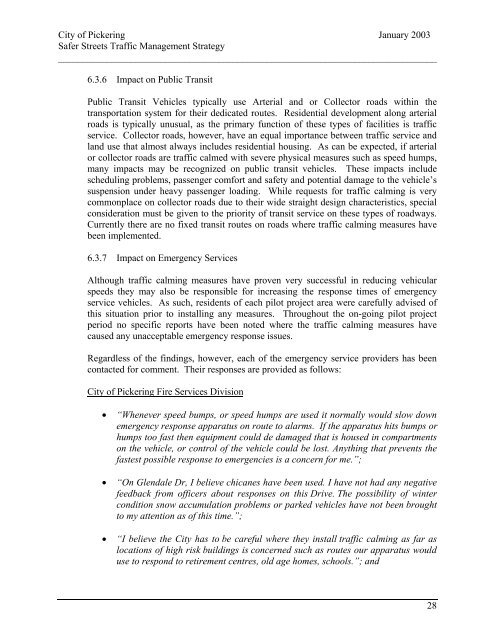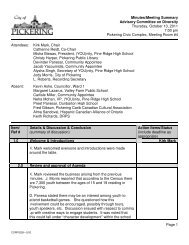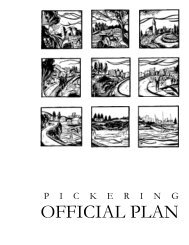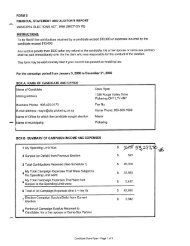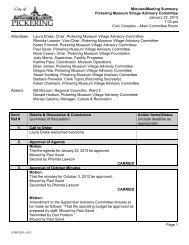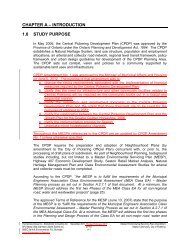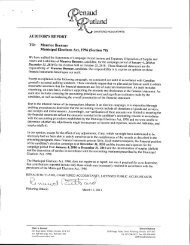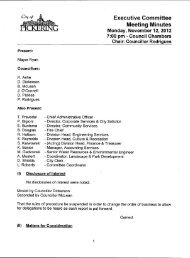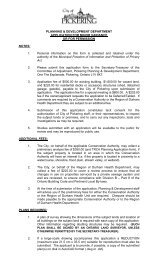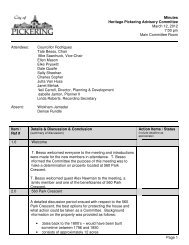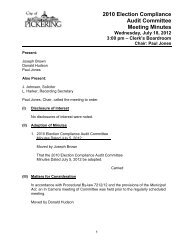foreword - City of Pickering
foreword - City of Pickering
foreword - City of Pickering
You also want an ePaper? Increase the reach of your titles
YUMPU automatically turns print PDFs into web optimized ePapers that Google loves.
<strong>City</strong> <strong>of</strong> <strong>Pickering</strong> January 2003<br />
Safer Streets Traffic Management Strategy<br />
______________________________________________________________________________<br />
6.3.6 Impact on Public Transit<br />
Public Transit Vehicles typically use Arterial and or Collector roads within the<br />
transportation system for their dedicated routes. Residential development along arterial<br />
roads is typically unusual, as the primary function <strong>of</strong> these types <strong>of</strong> facilities is traffic<br />
service. Collector roads, however, have an equal importance between traffic service and<br />
land use that almost always includes residential housing. As can be expected, if arterial<br />
or collector roads are traffic calmed with severe physical measures such as speed humps,<br />
many impacts may be recognized on public transit vehicles. These impacts include<br />
scheduling problems, passenger comfort and safety and potential damage to the vehicle’s<br />
suspension under heavy passenger loading. While requests for traffic calming is very<br />
commonplace on collector roads due to their wide straight design characteristics, special<br />
consideration must be given to the priority <strong>of</strong> transit service on these types <strong>of</strong> roadways.<br />
Currently there are no fixed transit routes on roads where traffic calming measures have<br />
been implemented.<br />
6.3.7 Impact on Emergency Services<br />
Although traffic calming measures have proven very successful in reducing vehicular<br />
speeds they may also be responsible for increasing the response times <strong>of</strong> emergency<br />
service vehicles. As such, residents <strong>of</strong> each pilot project area were carefully advised <strong>of</strong><br />
this situation prior to installing any measures. Throughout the on-going pilot project<br />
period no specific reports have been noted where the traffic calming measures have<br />
caused any unacceptable emergency response issues.<br />
Regardless <strong>of</strong> the findings, however, each <strong>of</strong> the emergency service providers has been<br />
contacted for comment. Their responses are provided as follows:<br />
<strong>City</strong> <strong>of</strong> <strong>Pickering</strong> Fire Services Division<br />
<br />
<br />
<br />
“Whenever speed bumps, or speed humps are used it normally would slow down<br />
emergency response apparatus on route to alarms. If the apparatus hits bumps or<br />
humps too fast then equipment could de damaged that is housed in compartments<br />
on the vehicle, or control <strong>of</strong> the vehicle could be lost. Anything that prevents the<br />
fastest possible response to emergencies is a concern for me.”;<br />
“On Glendale Dr, I believe chicanes have been used. I have not had any negative<br />
feedback from <strong>of</strong>ficers about responses on this Drive. The possibility <strong>of</strong> winter<br />
condition snow accumulation problems or parked vehicles have not been brought<br />
to my attention as <strong>of</strong> this time.”;<br />
“I believe the <strong>City</strong> has to be careful where they install traffic calming as far as<br />
locations <strong>of</strong> high risk buildings is concerned such as routes our apparatus would<br />
use to respond to retirement centres, old age homes, schools.”; and<br />
28


